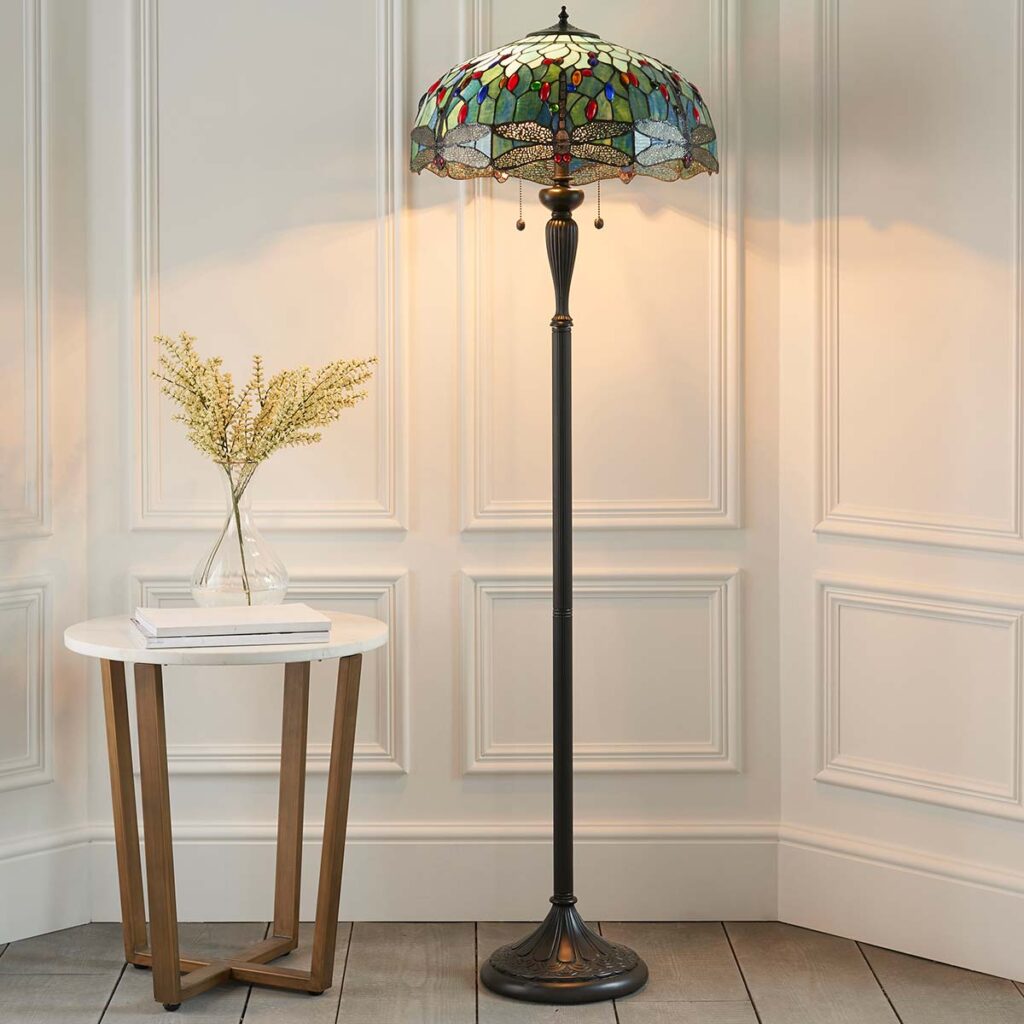
Tiffany lamps have captivated audiences for over a century with their dazzling stained glass shades which cast a warm, evocative glow when illuminated.
First designed by Louis Comfort Tiffany in the late 19th century, these ornate fixtures became synonymous with luxury and continue to enchant design aficionados today.
The Origins of Tiffany Lamps
Louis Comfort Tiffany was the pioneering artist behind the eponymous Tiffany lamps. Born in New York in 1848, Tiffany developed a passion for glassmaking and decorative arts from a young age.
He founded the interior design firm Louis Comfort Tiffany and Associated American Artists in 1879, gaining acclaim for his brilliant leaded-glass windows and mosaics.
In the 1890s, Tiffany turned his attention to lamp design. Inspired by the iridescent hues of butterfly wings, he experimented with layering and folding pieces of opalescent glass to create luminous lampshades with a three-dimensional, textured appearance.
Each shade was painstakingly assembled from countless pieces of hand-cut coloured glass using the copper foil technique developed by Tiffany. The glass was wrapped in fine copper foil and soldered together to form an abstract natural scene or pattern.
Tiffany’s elaborate table lamps, known as Tiffany lamps, became his most celebrated creations. The bases were constructed from bronze or pottery in Art Nouveau styles, complementing the brilliant organic hues and forms of the shades.
By 1900, the Tiffany lamp had become an international phenomenon and a status symbol of wealth and beauty.
The Allure of Tiffany Lamps
What is it about Tiffany lamps that captivates people to this day? Here are some of the defining features that contribute to their timeless allure:
-
Mesmerising Beauty of Stained Glass
The stained glass shades of Tiffany lamps exhibit an unrivalled, kaleidoscopic beauty that feels alive when illuminated. The luminous colours and textures create a sense of movement and dimension, reminiscent of shimmering leaves, butterfly wings or rippling water.
Tiffany used glass from different periods and regions for further tonal variation. The molten, organic appearance has an otherworldly, dreamlike quality unlike any other type of lighting.
-
Masterful Artistry & Technique
Producing a Tiffany lamp shade required tremendous creative vision and technical skill. Every shade is a unique work of art, painstakingly crafted from thousands of individual pieces of glass to realise Tiffany’s vision.
The precision and intricacy of the copper foil technique demonstrates outstanding mastery of the medium. Tiffany lamps reflect an admirable commitment to quality and craftsmanship from a bygone era.
-
Evocative Glow & Ambience
When illuminated, Tiffany lamps give off a radiant, multi-coloured glow unlike typical incandescent or overhead lighting. The ambient glow is evocative and romantic, transforming ordinary spaces into something special.
The lamps create a warm, inviting atmosphere that feels simultaneously vintage and contemporary. Many associate the signature Tiffany glow with luxury, sophistication and beauty.
-
Historic Significance
As pioneering Art Nouveau creations, Tiffany lamps hold great significance in design history. They reflect the aesthetics, ideals and craftsmanship of turn-of-the-century artisans.
Owning an original Tiffany lamp connects you to a remarkable period of innovation and style at the forefront of the modern era. The brand maintains an aura of exclusivity and prestige today.
-
Rarity & Value
Genuine antique Tiffany lamps are extremely rare. Only around 4,000 originals are estimated to exist, with the vast majority now in museums or private collections. Their scarcity significantly adds to their value as desirable collector’s items.
Lamps in good condition by Tiffany Studios can fetch anywhere from £10,000 to over £2 million at auction. Owning a Tiffany original is the pinnacle for serious antique lighting collectors.
Notable Tiffany Lamp Designs
Over his career, Louis Comfort Tiffany produced hundreds of different lamp designs showcasing his creative vision and technical skill. Here are some of the most celebrated and prized Tiffany lamp varieties:
-
Wisteria
The Wisteria lamp features a leaded glass shade evoking graceful dangling wisteria blossoms in purple and white hues. The flowers appear to sway, with dimensional pieces of glass adding shadows and depth.
Wisteria shades showcase Tiffany’s naturalistic style at its finest. Subtle variations exist, from two- colour to multicoloured blossoms.
-
Dragonfly
Dragonfly lamps feature artful stained glass shades depicting colourful dragonflies hovering over glistening pools of water. Iridescent wings, articulated bodies and shadows create a lifelike, kinetic effect.
Background hues range from bold and brilliant to paler, more ethereal watercolours. The dragonfly motif demonstrates Tiffany’s knack for marrying beauty and realism.
-
Pond Lily
The pond lily design features Tiffany’s signature luminous coloured glass crafted to resemble blooming water lilies. The petals and leaves appear to float across the shade in vivid emerald, jade, pink and yellow hues.
Some versions incorporate actual dried or pressed lily petals. The organic, asymmetrical composition reflects the tranquil essence of a pond ecosystem.
-
Peony
Peony shades showcase Tiffany’s mastery of floral motifs using nuanced colours and deft glasswork to capture texture and form. Shades display lush garden peonies with delicate ruffled petals in blushing pinks, fuchsias, ruby reds and creamy ivories. The majestic flowers practically burst with life, yet maintain an elegant poise.
-
Magnolia
Tiffany magnolia lamps feature goblet-shaped shades adorned with sculptural magnolia blooms. Petals graduate from dense coloured glass at the tips to translucent white bases for a striking ombre effect.
Long stems and leaves intertwine across the shade, with ribbed glass veins enhancing realism. Magnolias were one of Tiffany’s favourite flowers to interpret in glass.
Varieties of Tiffany Lamps
While stained glass shades remained integral across Louis Comfort Tiffany’s lighting designs, he produced an array of lamp forms to serve different decorative needs:
-
Table Lamps
Tiffany’s most famous and widely coveted lamps are the table lamps, featuring specially designed bases to hold the multi-shaped leaded glass shades.
Table lamps come in a range of base materials and styles, from simple bronze pillars to intricately modelled ceramic bases. They provide beautiful accent lighting and display pieces for tabletops.
-
Floor Lamps
Tiffany floor lamps feature taller metal stems topped with trademark stained glass shades, designed to illuminate entire rooms.
Popular base styles include simple rods to elaborate plant-form motifs. Floor lamps make dramatic decorative statements in living rooms, hallways and other open spaces.
-
Hanging Lamps
Tiffany hanging lamps suspend opulent leaded glass shades from long cords, allowing them to serve as dazzling pendant lights. Also known as Tiffany chandeliers, they come in single or multi-tiered formats for hanging above dining tables, entryways, above staircases and more.
-
Wall Lamps
Tiffany sconces or wall lamps feature stained glass shades affixed to a backplate or mounted onto an ornamental bronze bracket for display on walls. These fixtures provide ambient lighting while accenting hallways, bedrooms and other living spaces.
-
Billiard Lamps
Tiffany billiard lamps feature long, slender bronze stems capped by cylindrical stained glass shades. Designed to illuminate pool and billiard tables without obstructing game play, these speciality lamps showcased Tiffany’s creative problem-solving.
With such a diverse array of forms, Tiffany Studios produced lighting for nearly any need or space. But it was the signature multi-hued glass that ultimately made these fixtures true works of art.
The Legacy of Tiffany Lamps
Long after his passing in 1933, Louis Comfort Tiffany’s iconic lamp creations continue to enthral design lovers worldwide. Some key aspects of his lasting legacy include:
-
Inspiring future generations of artists & craftspeople – Tiffany lamps demonstrate the heights possible when creativity and technical mastery come together. Tiffany Studios set a standard in glass artistry that is still influential today.
-
Shaping the Art Nouveau movement – Tiffany lamps embodied the organic, nature-inspired aesthetic of Art Nouveau. Their flowing, asymmetrical forms helped define an era of design.
-
Introducing innovative glass techniques – Tiffany’s copper foil method revolutionised leaded glass, allowing for more intricate, multidimensional creations. Variations of this technique remain essential to stained glass art.
-
Synergy of form and function – Tiffany seamlessly merged beauty and utility in lighting design. The lamps provide ambient illumination while doubling as magnificent works of art.
-
Cultural significance – Tiffany lamps remain immortalised in film, literature, music and photography as symbols of beauty and luxury. Their glow is universally recognised.
-
Outstanding museum collections – Major institutions like the Metropolitan Museum of Art, the Museum of Modern Art and the Virginia Museum of Fine Arts have entire collections dedicated to Tiffany lamps.
-
Enduring value – Scarcity continues to drive the value of authentic Tiffany lamps to stratospheric levels at auction. Their status as valuables persists.
Over a century later, Tiffany’s spectacular leaded glass creations still represent the pinnacle of fine craftsmanship and exquisite design.
Their rich colours, evocative ambience and innovative artistry live on as Louis Comfort Tiffany’s lasting imprint upon decorative arts. The continued appreciation of Tiffany lamps ensures his incredible vision will endure for generations to come.



Comments are closed.